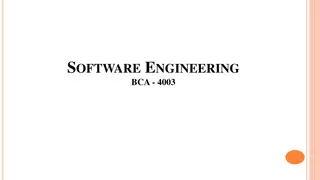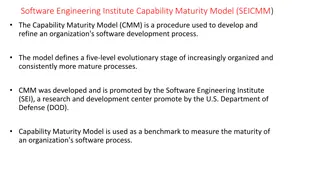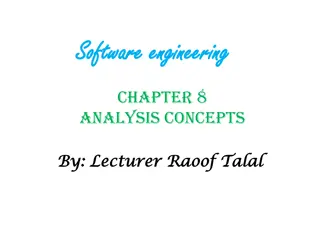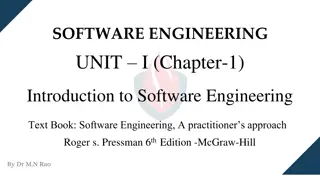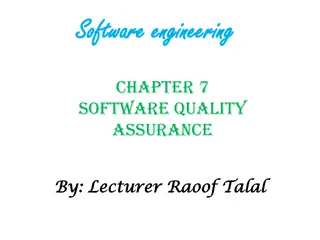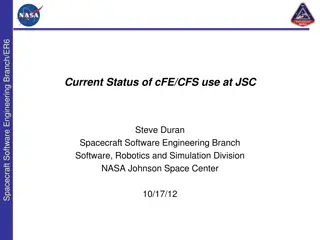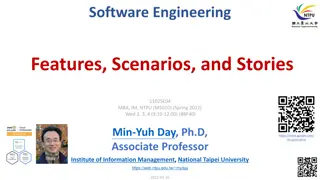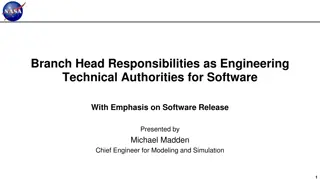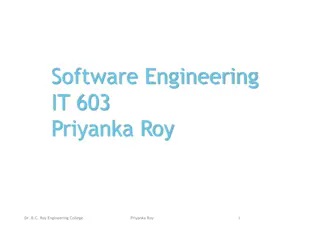Understanding Software Engineering Fundamentals
Explore the significance of software in modern economies, the attributes of good software, software engineering principles, software processes, and process models. Learn how software engineers ensure functionality, maintainability, dependability, efficiency, and usability in software development.
Download Presentation

Please find below an Image/Link to download the presentation.
The content on the website is provided AS IS for your information and personal use only. It may not be sold, licensed, or shared on other websites without obtaining consent from the author. Download presentation by click this link. If you encounter any issues during the download, it is possible that the publisher has removed the file from their server.
E N D
Presentation Transcript
ISNE101 Dr. Ken Cosh
Recap We ve been talking about Software Application vs System Software Programming Languages Vs Natural Languages Syntax, Semantics && Ambiguity! This week Introducing the SDLC
Why study about Software? The economies of ALL developed nations are dependent on software More and more systems software controlled Software production expenditure represents a significant fraction of GNP in all developed countries Software costs often dominate system costs. The costs of software on a PC are often greater than the hardware cost Software costs more to maintain than it does to develop. For systems with a long life, maintenance costs may be several times development costs
What are the Attributes of Good Software? Deliver required functionality and performance to user, and be maintainable, dependable, usable Maintainability Software must evolve to meet changing needs Dependability Software must be trustworthy Efficiency Software should avoid wasting system resources Usability Software must be usable by the users for which it was designed
What is Software Engineering? Software engineering is an engineering discipline which is concerned with all aspects of software production Software engineers should adopt a systematic and organised approach to their work and use appropriate tools and techniques depending on the problem to be solved, the development constraints and the resources available
What is a Software Process? Set of activities whose goal is the development or evolution of software Generic activities in all software processes are: Specification - what the system should do and its development constraints Development - production of the software system Validation - checking that the software is what the customer wants Evolution - changing the software in response to changing demands
What is a Software Process Model? A simplified representation of a software process, presented from a specific perspective Examples of process perspectives are External perspective Structural perspective Behavioural perspective
The Software Process A structured set of activities required to develop a software system: Specification Design Validation Evolution A software process model is an abstract representation of a process. It presents a description of a process from some particular perspective
Generic Software Process Models The Waterfall model Separate and distinct phases of specification and development Evolutionary development Specification and development are interleaved Reuse-based development The system is assembled from existing components
Waterfall Model Requirements definition System and software design Implementation and unit testing Integration and system testing Operation and maintenance
Waterfall Model Phases Requirements analysis and definition System and software design Implementation and unit testing Integration and system testing Operation and maintenance The drawback of the waterfall model is the difficulty of accommodating change after the process is underway
Waterfall Model Problems Inflexible partitioning of the project into distinct stages This makes it difficult to respond to changing customer requirements Therefore, this model is only appropriate when the requirements are well-understood
Evolutionary Development Exploratory development Objective is to work with customers and to evolve a final system from an initial outline specification. Should start with well- understood requirements Throw-away prototyping Objective is to understand the system requirements. Should start with poorly understood requirements
Evolutionary Development Concurrent activities Initial version Specification Outline description Intermediate versions Development Final version Validation
Evolutionary Development Problems Lack of process visibility Systems are often poorly structured Special skills (e.g. in languages for rapid prototyping) may be required Applicability For small or medium-size interactive systems For parts of large systems (e.g. the user interface) For short-lifetime systems
Reuse-oriented Development Based on systematic reuse where systems are integrated from existing components or COTS (Commercial-off-the- shelf) systems Process stages Component analysis Requirements modification System design with reuse Development and integration
Reuse-oriented Development Requirements modification System design with reuse Requirements specification Component analysis Development and integration System validation
Process Iteration System requirements ALWAYS evolve in the course of a project so process iteration where earlier stages are reworked is always part of the process for large systems Iteration can be applied to any of the generic process models Two (related) approaches Incremental development Spiral development
Incremental Development Development and delivery is broken down into increments with each increment delivering part of the required functionality User requirements are prioritised and the highest priority requirements are included in early increments Once the development of an increment is started, the requirements are frozen though requirements for later increments can continue to evolve
Incremental Development Design system architecture Define outline requirements Assign requirements to increments Integrate increment Validate system Develop system increment Validate increment Final system System incomplete
Incremental Development Advantages Customer value can be delivered with each increment so system functionality is available earlier Early increments act as a prototype to help elicit requirements for later increments Lower risk of overall project failure The highest priority system services tend to receive the most testing
Extreme Programming New approach to development based on the development and delivery of very small increments of functionality Relies on constant code improvement, user involvement in the development team and pairwise programming
Spiral Development Process is represented as a spiral rather than as a sequence of activities with backtracking Each loop in the spiral represents a phase in the process. No fixed phases such as specification or design - loops in the spiral are chosen depending on what is required Risks are explicitly assessed and resolved throughout the process
Spiral Model of the Software Process Determine objectives alternatives and constraints Evaluate alternatives identify, resolve risks Risk analysis Risk analysis Risk analysis Opera- tional protoype Prototype 3 Prototype 2 Risk analysisProto- REVIEW type 1 Requirements plan Life-cycle plan Simulations, models, benchmarks Concept of Operation S/W Product design requirements Detailed design Requirement validation Development plan Code Unit test Design V&V Integration and test plan Integration test Plan next phase Acceptance test Develop, verify next-level product Service
Spiral Model Sectors Objective setting Specific objectives for the phase are identified Risk assessment and reduction Risks are assessed and activities put in place to reduce the key risks Development and validation A development model for the system is chosen which can be any of the generic models Planning The project is reviewed and the next phase of the spiral is planned


